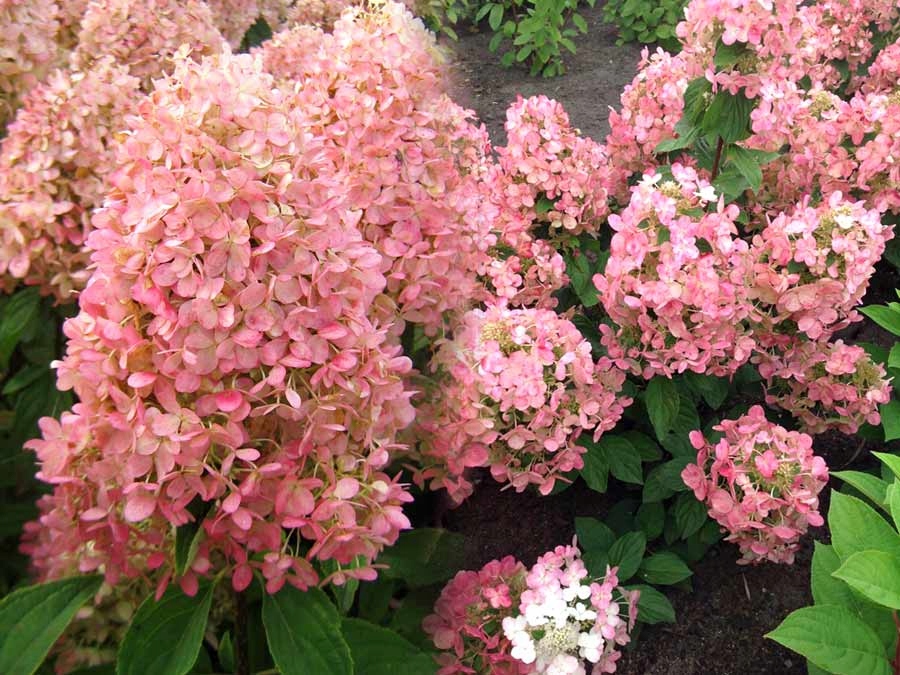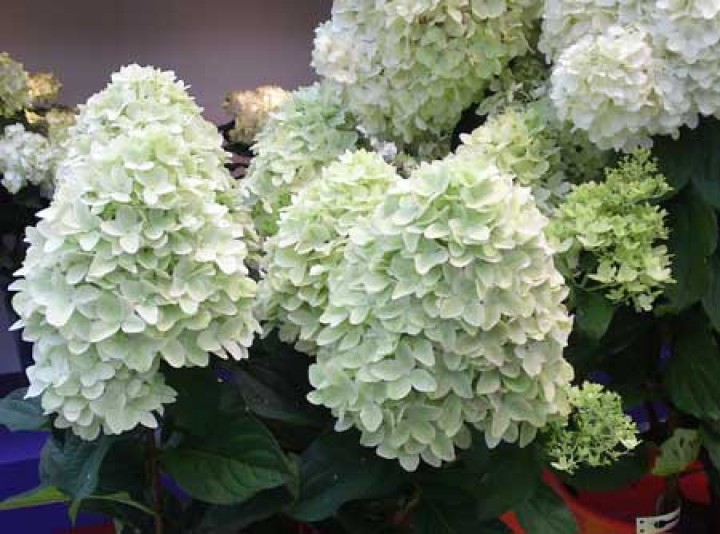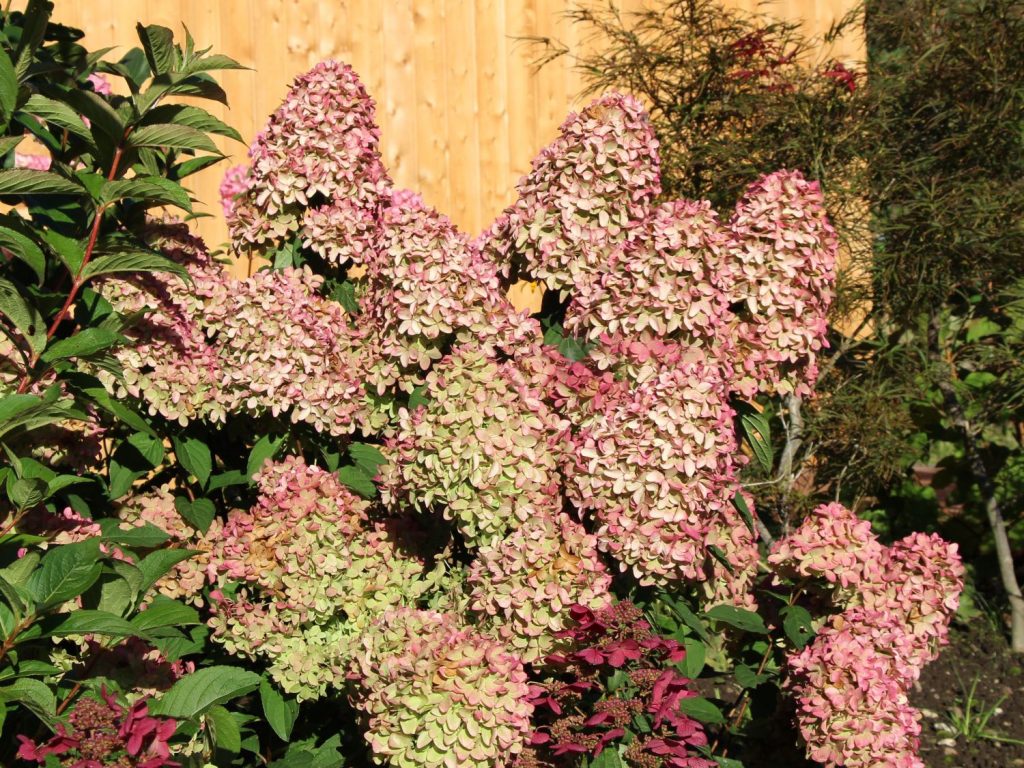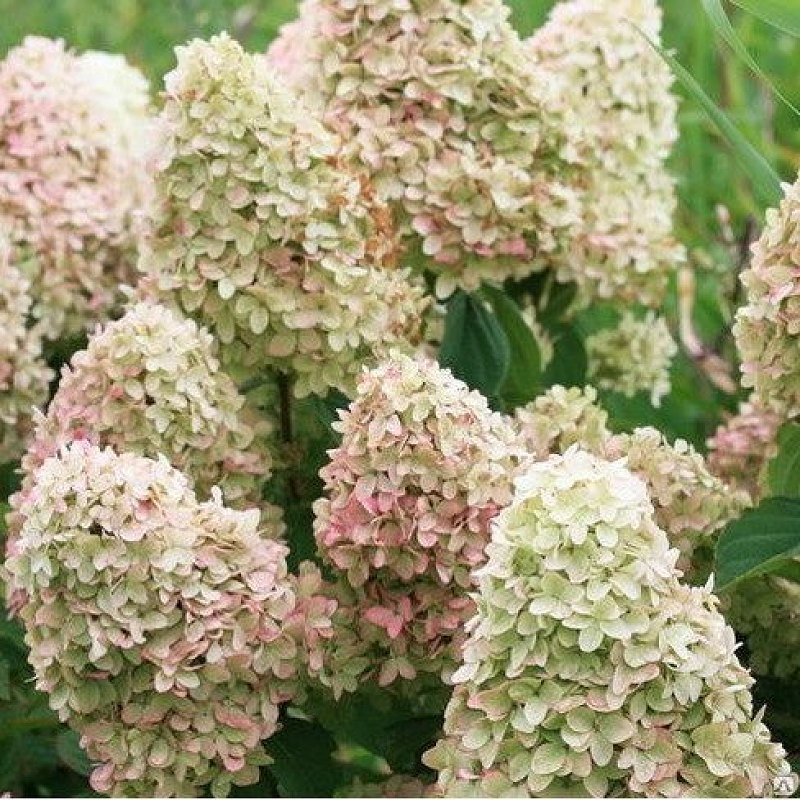Panicle hydrangea Magic Candle - useful information about the variety
Hydrangea variety Magic Candle was created in 2007 under the patronage of the leading French company Sapho, engaged in the development and promotion of new ornamental garden plants. The Dutch scientists of the Boot & Co Boomkwekerijen nursery, located in the Boskop community, carried out the breeding work directly.
- Description of the variety
- Landing
- Timing
- Seat selection
- Preparation of planting material
- Technology
- Growing rules
- Watering mode
- Top dressing
- Care features
- During flowering
- During the rest period
- Preparing for winter
- Reproduction
- Reproduction by layering
- Cuttings
- Diseases and pests
- Landscape use
- Gardeners reviews
- Useful videos

Hydrangea Magic Candle description
Description of the variety
Magic Candle belongs to the subspecies of panicle hydrangeas. The international name is Hydrangea paniculata Magical Candle Bokraflame.
The variety is distinguished by the compact size of the bush, not exceeding 1.2-1.5 m in height and 1-1.2 m in width. Stems are strong, erect, with pubescent leaves of bright green color.
The indisputable advantage of the plant is its flowers. The huge porcelain white flower heads appear to be illuminated from within, creating the illusion of a surreal soft glow in the sunlight. It is no coincidence that the name Magical Candle in translation sounds like "Magic Candle".
The flowering period is standard: from July to the end of September.
White flowers with a pistachio-yellow core are grouped in large, very dense pyramidal panicles, reaching 30 cm or more. At their peak, the forms become snow-white. Closer to autumn, the petals begin to turn pink gradually, from the lower tiers - to the top. At the end of flowering, they become completely reddish.
Inflorescences, despite their size, hold firmly enough on high vertical stems. The dense, lacy panicles of this variety are one of the most beautiful in their class.
Landing
Hydrangea paniculata Magical Candle grows most productively on moist, drained, rich in organic matter, loose acidic soils. It easily tolerates temporary waterlogging, on the contrary, it suffers from drought. It can grow on neutral soils, and will feel oppressed on alkaline soils.

Magic Candle hydrangea description
You can acidify the site with moss collected from raised bogs or with special fertilizers. Heavy clay soil without the addition of baking powder contributes to root rot.
Timing
You can plant it all year round.
- In winter, cuttings can be planted in flower pots at home.
- The best time for rooting outdoors is from mid-May to June.
- In autumn, you can plant until October, but not less than a month before frost.
Seat selection
Magic Candle loves light areas. However, an area open to wind and sun is not the best option. Preference is given to a place that is well lit in the morning or evening hours, and protected from direct sunlight at noon. Preparation consists of clearing weeds and debris.
Preparation of planting material
Healthy specimens are selected. The presence of diseases will be indicated by spots on the leaves, their discoloration, traces of mold and rotting roots.
When planting seedlings with an open root system, the roots are shortened and soaked for a couple of hours in a disinfectant solution. For example, potassium permanganate.
Technology
To plant hydrangeas, dig a hole twice as wide as the root ball and the same depth. Approximate dimensions: 40x40x40 or 50x50x50 cm. Before backfilling the earth, a drainage 10-15 cm thick from gravel, expanded clay, ceramic fragments or broken brick is laid out at the bottom.
The excavated soil is mixed with compost and baking powder if the soil is heavy. If the soil is sandy, poor, mineral fertilizers are added. The seedling is placed in the center of the hole, the roots are straightened and carefully covered with the prepared substrate.
The land around the bush is watered with 1-2 buckets of water to settle the soil. If necessary, add a new one and trample. At the very end, the root zone is mulched and watered again. Recently, the bark of coniferous trees has been used as mulch. It prevents moisture evaporation from the ground, disinfects and acidifies the soil.
Attention! The root collar should not be buried in the ground. The ideal position is at ground level or 5-10 mm higher.
Growing rules
Hydrangea has a strong immune system. She is unpretentious, steadfastly endures conditions that are not suitable for her. However, in order for it to show itself in all its glory, it is necessary to adhere to some recommendations.

Hydrangea Magic Candle description photo
Watering mode
Magic Candle, like any hydrangea, loves water. However, the intensity of irrigation directly depends on the composition of the soil and the amount of precipitation. On drained loams with regular rainfall, additional watering should not be required. On sandy soils, moisture goes away faster.
If the weather is dry, it is recommended to water the bush at least once a week with a volume of 30-40 liters.
Mulching will help retain precious moisture. However, when distributing mulch, it is desirable that it does not fall asleep on the root collar. The best results are obtained with drip irrigation. It helps to reduce the amount of water and can also be used for liquid metered feeding.
Attention! Chlorine-laden, cold, hard water from a pipeline will not work.
Top dressing
- In the spring, at the beginning of growth, combine organic feeding with mineral complexes.
- During the budding period - phosphorus-potassium fertilizers.
- In July and August, it is useful to feed the mullein infusion.
- In autumn, rotted manure or compost is used as mulch: 1-2 buckets per bush.
It is important to avoid excess nitrogen. It provokes the development of a disease such as chlorosis.
The intensity of fertilizing directly depends on the fertility of the soil. If organics are already in abundance, you can limit yourself to the introduction of minerals and trace elements.
Care features
During flowering
The variety is distinguished by large inflorescences. Under favorable conditions, they grow so large that the stems in strong winds, especially after a rainstorm, can not withstand. Therefore, it is advisable to provide protection from the wind or to strengthen the bush with supports, stretch marks.

Magical candle
During the rest period
An important step in the formation of a beautiful and healthy bush is pruning. Panicle hydrangea blooms on young shoots of the new season, so it is better to do this in early spring - before the start of sap flow and bud swelling.
Pre-winter pruning is allowed when the plant is already dormant - after it it is easier to cover the bush for the winter in areas with severe winters.
First of all, thin, crooked, diseased and excess shoots are removed. The main skeletal woody branches are also cut to half, or even lower. Even if 15-30 cm "stumps" remain above the ground, the Magic Candle will bloom in summer. Moreover, extreme pruning at intervals of 5-7 years is beneficial for rejuvenating the bush.
Preparing for winter
The homeland of the panicle hydrangea is the harsh Far East.
Even if the stems die in frost, they will grow back over time. The main thing is to protect the roots.To do this, the root zone is mulched in autumn: a layer of straw, compost, hay, peat, rotted manure, bark, wood chips, fallen leaves, sawdust or other material, preferably of organic origin, is poured under the bush. The thickness depends on the winter hardiness zone: in the south, 5 cm is enough, in the north - up to 20 cm.
Reproduction
Hydrangea can be propagated by seed, layering, dividing a bush or root, or cuttings. Growing from seeds is the most laborious method and does not guarantee the result. It is mainly used by scientists for breeding work.

Hydrangea Magic Candle reviews
Reproduction by layering
The process takes 2 years but gives good results. In the first year, the lateral shoot is bent to the ground during the growing season, fixed and instilled in the middle of the stem. By the end of autumn, roots will sprout in the buried part. In the second year, in the spring, the stem is cut off from the mother bush and transplanted to a new place.
Cuttings
The most reliable method with an efficiency of 95-99%:
- When the foliage has grown, the upper part of the shoot is cut off with a length of 10-15 cm.
- 1-2 pairs of lower leaves are cut off, keeping the upper ones.
- They are kept in Kornevin for a couple of hours.
- They are planted in a fertile loose substrate, watered.
- A mini-greenhouse is being built, which is regularly ventilated.
- Roots appear in 2-3 weeks.
Diseases and pests
The plant rarely gets sick. In the case of a weakened immune system, some problems are possible.
| Disease | Treatment | Prophylaxis |
| Leaf spot | Depends on the cause of the disease. For bacterial damage, bactericidal preparations are used, for fungal infections - fungicides. Or broad action (Bordeaux mixture). | Avoid thickening of the landings. Strengthen with immunomodulators in the spring. |
| Powdery mildew | A wide range of fungicides (Baktofit, Bordeaux mixture, Chistotsvet, Topaz, Fitosparin, copper sulfate). | Clean up heaps of garbage and weeds in time. Avoid waterlogging of the soil. |
| Rust | Destroy affected shoots. Treat with "Topaz", "Bactofit" or Bordeaux liquid. | When purchasing new plants, quarantine them. Monitor the site. Feed on time. |
Landscape use
Hydrangea Magic Candle is universal. With her, they create magnificent mixborders in combination with other varieties of Hortensia, ornamental shrubs, low-growing conifers, tall grasses.

Hydrangea paniculata magical candy photo
The manufacturer advises using Magical Flame, Everlasting Crimson, Bokrashine First Editions Shining Weigela, Elsdancer Tiny Dancer lilac as companion plants.
Often hedges are formed, both in personal plots and in city parks. The plant tolerates urban microclimate well, is not susceptible to dust and high CO2 content.
It looks great in a single planting in the middle of a lawn, or in a pot on a terrace. Dried flowers demonstrate high decorative qualities - they will make long-lasting flower arrangements and Ekibans.
Gardeners reviews
The variety is not inferior in decorativeness to the newer subspecies of panicle hydrangeas. It has good winter hardiness (-25 ° C), abundant flowering, and disease resistance. A gradual color change is also a plus. The main disadvantage, which is visible, is the possible drooping of the stems under the weight of the peduncles.

